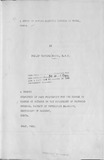| dc.description.abstract | This investigation vas carried out to determine the incidence of mastitis in a specified area, King’ong in Nyeri, to evaluate the effectiveness of the various methods in reducing the level of mastitis under the 'Kenyan environment.
One hundred milking cows were used in the investigation. This included 25 milking cows picked from each of 4 selected dairy herds. Each herd had to be in a handmilking practice. The investigation was done in two phases
(a) Dairy herd management was evaluated and
recorded. Then, using Mastitis Indicator Test
solution (MIT) on quarter milk samples, the numerical
values of milk reactions were recorded for a period of
sever months to establish the incidence of clinical 5
and subclinical mastitis. Bacterial survey through culturing proceedures and sensitivity tests was done on random samples.
(b) The second phase included all the procedures in the first phase of investigation but with control methods being apnlied in all herds.
The control methods included
(i) Teat sanitation: An Iodophor solution was used in teat dinning immediately after milking.Udder sanitation immediately before
milking. The udder washing was done with a dilute solution of a quarter.ary ammonium detergent.
(iii) Dry cow therapy (DOT).
(iv) Clinical case treatment and
(v) Equipment sanitation using the quarter.ary ammonium solution.
All these mastitis control methods were used in combination for a period of seven months. The result was a drop in subclinical mastitis incidence from 57.5 percent (from the first phase) to 37.8 percent (in the control phase). Simultaneously, there v/as a reduction in the incidence of clinical mastitis from 4.8 percent to 2.4 percent.
117 quarters were dried and infused with a dry cow antibiotic preparation. Of these quarters,
91 were subclinically mastitic. In the subsequent lactation only 11 were found to be subclinical. This meant that 80 quarters had been cleared of this category of mastitis. This is a 87.9 percent clearing of subclinical mastitis from the dry cows.
The most predominant bacterial isolates were: Staphylococcus aureus. Streptococcus aralactjae ana Klebsiella pneumoniae. All the isolates from the
clinical cases were found to be sensitive to the most commonly used antibiotics.
There was clear evidence that under the conditions in which the dairy industry is operated in King’ong’o, Nyeri, with proper application of the reccmmeded mastitis control methods, the incidence of both subclinical and clinical mastitis should be lower than is actually observed.
However, for the control methods to be appreciated, the milkman and the farm owners should understand the basic principles of each control method and be convinced of the advantage there in. The udder and the milkman’s hygiene should be further emphasised. | en_US |



